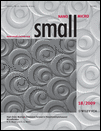Parallel Preparation of Densely Packed Arrays of 150-nm Gold-Nanocrescent Resonators in Three Dimensions
Abstract
Metallic nanostructures show interesting optical properties due to their plasmonic resonances, and when arranged in three-dimensional (3D) arrays hold promise for optical metamaterials with negative refractive index. Towards this goal a simple, cheap, and parallel method to fabricate large-area, ordered arrays of 150-nm gold nanocrescents supporting plasmonic resonances in the near-infrared spectral range is demonstrated. In this process hexagonally ordered monolayers of monodisperse colloids are prepared by a simple floating technique, and subsequently the individual particles are size-reduced in a plasma process and used as a shadow mask with the initial lattice spacing. The resulting two-dimensional array of plasmonic resonators is coated with a transparent silica layer, which serves as a support for a second layer prepared by the identical process. The mutual orientation of the nanostructures between the individual layers can be freely adjusted, which determines the polarization-dependent absorption of the array and opens the possibility to introduce chirality in this type of 3D metamaterial. The iteration of this simple and efficient methodology yields 3D arrays with optical features as sharp as those of the individual nanocrescents, and shows strong potential for large-scale production of high-quality optical metamaterials.




